Portsmouth Floodwall Murals
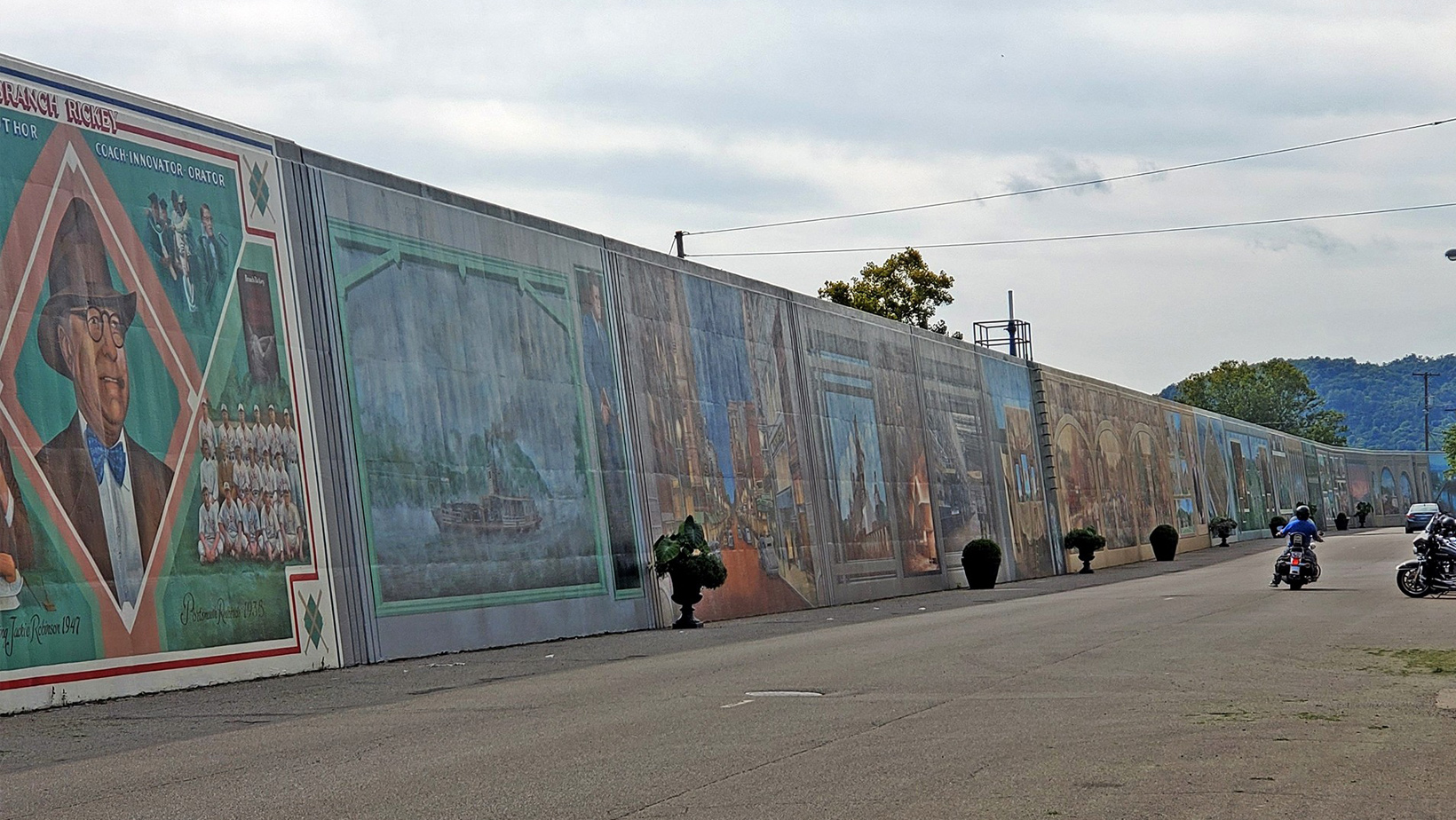
Donna Arnett
Portsmouth Murals, Inc.
740-353-7647
darnett@portsmouth.org
429 Front Street, Portsmouth, OH
The stimulus for the entire mural project began in February 1992. Dr. Lou Chaboudy and his wife, Ava, were hosting a AAA motor coach tour that included Steubenville, Ohio. After enjoying the murals in Steubenville, they reflected, “Our own floodwall has protected us well, but it is an eyesore. It would be a great place for murals.” Other city leaders and officials visited Steubenville in June and agreed. Fund raisers were held in December 1992 and again in April 1993. Portsmouth Murals, Inc. (PMI) was formed as a nonprofit, all volunteer organization.
Muralist Robert Dafford was then commissioned to paint the first mural. The Carl Ackerman photographic collection was reviewed and photos depicting a view of Portsmouth in 1903, as seen from the Kentucky side of the Ohio River, were selected. The dedication ceremony of this first mural was in May 1993.
The Floodwall Mural Project was a carefully designed effort between PMI and Dafford. Hundreds of different ideas were suggested. Instead of painting a 19th century mural here and a 16th century mural there, they developed the concept of an historical timeline of the Portsmouth area. The first mural on the east end of the floodwall depicts the Mound Builders. Traveling east to west, the chronological history of the Ohio Valley comes alive – ending with a mural of the U.S. Grant Bridge in 2001.
All murals along this original section of the floodwall (along Front Street between Washington Street and Madison Street), chronicling the history of the area, are now complete. A large measure of the project’s success can be attributed to the volunteer work of Bob Cook. In October 1994, he became PMIʼs Executive Coordinator.
The Floodwall Mural Project is an ongoing endeavor of PMI. Financial support comes from individual and corporate contributions, public and foundation grants, fund-raising events and the sale of mural merchandise. These financial needs remain as there are on-going maintenance of the murals as well as additional mural projects which continue to develop. Since the dedication of the murals, four unique mural panels have been added along various sections of the floodwall and most recently, a five mural has been started which is currently being painted on the riverfront side of the floodwall near the Court Street Landing.
(https://portsmouthmurals.com/about/)
The purpose of the floodwall mural project is to create an outdoor art gallery depicting the last two centuries of the history of Portsmouth Ohio and the surrounding area. The section of floodwall included in the project is 20 feet high and extends for 2,090 feet along Front Street in the historic Boneyfiddle District of downtown Portsmouth. Painting began in 1993.
Robert Dafford of Lafayette, Louisiana, is the artist for the entire project. An internationally known muralist with more than 20 years’ experience, Robert has created more than 200 murals throughout the United States, Canada, and Europe. The highlight of much of his work is a three-dimensional illusion such that viewers feel they can “step into” the painting, and this effect is shown in many of the Portsmouth murals. The murals are proving to be a tremendous tourist attraction. Robert’s painting season in Portsmouth is from May through September. (https://portsmouthmurals.com/2019/04/02/the-journey-begins-2/)
Along the river side of the mural, the city of Portsmouth has created a Portsmouth Wall of Fame collection of murals. The star murals along the length of the floodwall honor notable people who are from or have strong ties to the Portsmouth area.

Greenville Murals
In addition to being the Treaty City (where the treaty was signed with Native American tribes to open the west for expansion for the United States), Greenville, Ohio, is the Annie Oakley Capital of the World.
Along with the Garst Museum, The Annie Oakley Foundation, and a statue of Annie Oakley, starting in 2023, Greenville began a mural program in their downtown including an Annie Oakley mural.
The first two murals installed depict the history of Greenville.
Ellen Litchfield
Greenville Mural Committee
937-623-1234
ellenlitchfield2@gmail.com
521 South Broadway (postcard)
117 East 5th Street, Greenville
(Annie Oakley)
One mural (50 feet x 20 feet) (620 South Broadway) recreates a large-letter postcard sold in 1952 in downtown Greenville’s McClurg’s Book Store, located at 521 South Broadway; the postcard was created by Curt Teich and Company, which operated in Chicago for over 70 years prior to its 1978 closing. Opened as Gibson and Wenger Book Shop in 1910, the local store was purchased by Ray Wenger in 1915, who owned it until 1951. In 1950, Merle Oliver and Roy McClurg were proprietors of the wholesale business selling books, office supplies and equipment, stationery, and school supplies. Generations of youngsters and their parents visited the store in early September to purchase school books as well as Golden Rod tablets, Crayola crayons and other supplies required for all local schools.
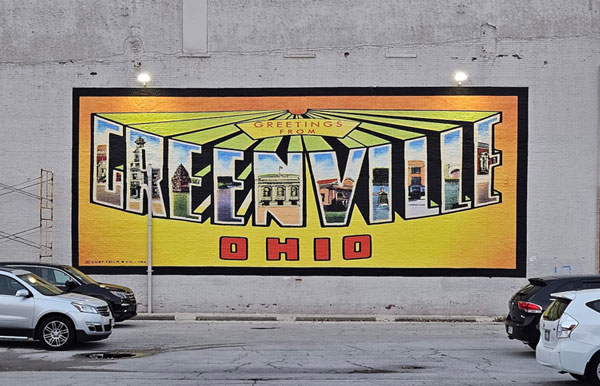
This postcard was discovered at Garst Museum, part of a collection created by long-time Greenville resident Kay Brown, whose son Dick had digitized his mother’s compilation. The image itself was then digitized and enlarged by Timothy Wells of Timothy Wells Art Consulting, and printed on vinyl as a 20 foot by 50 foot mural by Joe Wintrow at Wintrow Signs and Designs. Reproductions of the Greetings from Greenville design as a real postcard are available for sale at the Hive Collective on Broadway. (https://www.mainstreetgreenville.org/projects-programs/downtown-greenville-mural-project)
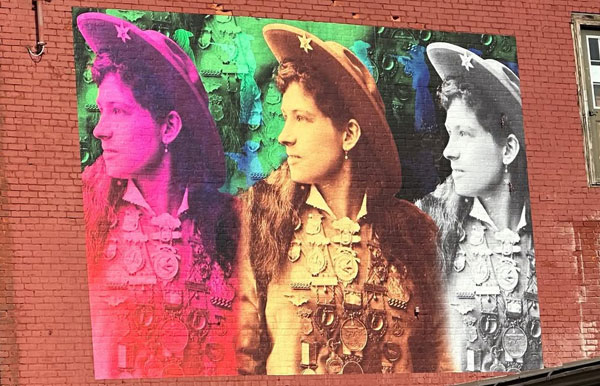
The second mural was installed on November 8, 2023 (117 East 5th Street), it is a 20′ by 15′ contemporary digital version of celebrated Darke County native Annie Oakley appropriately placed on the walls of Sure Shot Tap House (one of Annie’s nicknames was Sure Shot). Three colorful images of the sharpshooter look out over YOLO Park in a mural created by Timothy Wells and installed by Joe Wintrow. Andrew Riffle, owner of Sure Shot Top House, contributed funds in support of this installation.
This mural honors a Darke County native whose talents captivated audiences around the world. Annie Oakley, born Phoebe Ann Mosey near North Star, Ohio, was an iconic star of Buffalo Bill’s Wild West, gaining international fame for her sharpshooting skills in the late nineteenth century. She died November 3, 1926, in Greenville, Ohio, but her legendary life continues to be celebrated to this day. (https://www.mainstreetgreenville.org/projects-programs/downtown-greenville-mural-project)
In addition to these two murals depicting the history of Greenville, there are also power box murals created by Greenville High School art students, and a large mural by watercolor artist Don Mong depicting the fort recreated in the Greenville City Park.
Fort Recovery, Ohio
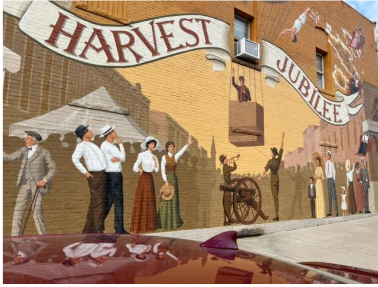
Nancy Knapke, retired
Fort Recovery State Museum, Fortnancymk@gmail.com
Kim Rammel fortrecoveryhistoricalsociety@gmail.com
102 S. Wayne Street (Harvest Jubilee)
117 Wayne Street
(The Battle of Wabash 1791)
Mention “The Harvest Jubilee” and the prediction is that every person in and around Fort Recovery knows about which you speak (although most people now just refer to it as the “Jubilee.”) The Harvest Jubilee was a multi-day event going back to 1905. It was a time when farmers and merchants came together to celebrate the harvest. Games were played, balloon ascensions were held, midway acts were presented, and it was quite the festive event of the year. The mural presents the jubilee as it would have been celebrated in those early days.
Local folks and visitors to the town now stand back and imagine life in those early days (before electronic entertainment and easy travel) and dream what it would have been like to live in those days when the ride on the Ferris wheel, winning a prize at the ball toss, or watching highwire acts was the highlight of the year. When the community of the Fort Recovery area came together in fun and camaraderie.
Before tackling the (70’/30’ masonry building surface mural) expert historian and artist, Dan Keyes drew/painted a small rendition of what the mural would look like, using muted tones and creating the exact “feeling” desired and suggested by the mural committee. The mural committee reflected on the scene and made a few suggestions to “carry” even more of the Jubilee history. Keyes was always open to community suggestions but held firm on points of artistry and history.
In November 1969, Ida Holdgreve, at age 88, took her first flight. She had never flown while working with airplanes, and the Dayton Area Chamber of Commerce set out to change that. Ida’s flight gained national attention, much to her surprise. “You know, I didn’t think they would make such a big deal out of it. I just wanted to fly,” Ida said when asked about her thoughts on her sudden celebrity status. The flight path took Ida sailing over the Wright Company in West Dayton. Following her flight, Ida recalled that it was quite difficult to hear in the air, which she didn’t like, but that “the clouds look just like wool,” a statement fitting for a seamstress. Apparently, the view made up for the noise, as Ida stated that she very much enjoyed the flight.
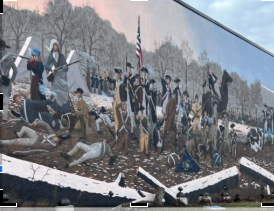
The Battle of Wabash 1791: Although there is a state museum located in Fort Recovery and dedicated to the battles that took place there on the banks of the Wabash, the state museum is open only seasonally, and there is a charge to enter. The mural committee thought it was important to have a large mural dedicated to the Wabash Battle of 1791, the greatest loss ever suffered by the US Army and the greatest victory ever, by a confederation of Native Americans. (General St. Clair vs. Little Turtle and Blue Jacket etc.)
This was to be an attraction that portrayed in detail and interest and accuracy the significance and terror of that battle. One that would attract visitors year-a-round, day and night. Artist Keyes, gathered material from the museum, but his own personal knowledge having worked in military museums of that time period and having a personal keen interest in history well-prepared him for this work of an unforgettable moment in military history. Historians with a keen eye see the detail in the uniforms, the accuracy of the military hardware, the terror in the participants faces, and the symbolism cleverly included in the painting. This is one painting into which, any observer can see, the artist put his heart and soul.